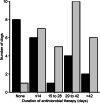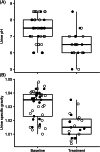Efficacy of medical dissolution for suspected struvite cystoliths in dogs
- PMID: 34469023
- PMCID: PMC8478031
- DOI: 10.1111/jvim.16252
Efficacy of medical dissolution for suspected struvite cystoliths in dogs
Abstract
Background: Medical dissolution of struvite uroliths in dogs is commonly recommended, but data on success rates and complications are limited.
Objectives: To evaluate the efficacy of medical dissolution for suspected struvite cystoliths in dogs.
Animals: Fifty client-owned dogs fed a therapeutic dissolution diet, with or without administration of antimicrobials, for treatment of suspected struvite cystoliths.
Methods: Single institution, retrospective case series. Medical records were reviewed for dogs with at least 1 follow-up visit. Dissolution success, complications, and possible predictors of success were evaluated.
Results: Full dissolution of cystoliths was achieved in 58% (29/50) of dogs within a median of 35 days (range, 13-167). Of 21 dogs without success, 7 each had partial dissolution, no dissolution, or undetermined outcome. Uroliths containing >10% nonstruvite mineral were common in the nonsuccess group (11/16 analyzed). Maximum urolith diameter, number of uroliths, and baseline urine pH did not differ significantly between dogs with and without success. Dissolution was more likely in dogs receiving antimicrobial therapy (OR = 16.3, 95% confidence interval 1.9-787.4, P = .002). Adverse events occurred in 9 dogs (18%); urethral obstructions were the most common, but 3 of 4 dogs with this complication were obstructed on presentation, before trial initiation.
Conclusions and clinical importance: Results support a medical dissolution trial for dogs with suspected struvite cystoliths. If no reduction in urolith size or number occurs by 1 month, a nonstruvite composition is likely, and alternative interventions should be considered. Dogs presenting with urethral obstructions should not be considered candidates for medical dissolution.
Keywords: canine; magnesium ammonium phosphate; stones; urinary tract infection.
© 2021 The Authors. Journal of Veterinary Internal Medicine published by Wiley Periodicals LLC. on behalf of the American College of Veterinary Internal Medicine.
Conflict of interest statement
Jody Lulich and Eva Furrow are members of the Minnesota Urolith Center which is supported in part by an educational gift from Hill's Pet Nutrition. No other authors have a conflict of interest.
Figures





References
-
- Low WW, Uhl JM, Kass PH, et al. Evaluation of trends in urolith composition and characteristics of dogs with urolithiasis: 25,499 cases (1985‐2006). J Am Vet Med Assoc. 2010;236:193‐200. - PubMed
-
- Lulich JP, Osborne CA, Albasan H, Koehler LA, Ulrich LM, Lekcharoensuk C. Recent shifts in the global proportions of canine uroliths. Vet Rec. 2013;172:363. - PubMed
-
- Osborne CA, Lulich JP, Polzin DJ, et al. Medical dissolution and prevention of canine struvite urolithiasis. Twenty years of experience. Vet Clin North Am Small Anim Pract. 1999;29:73‐111. - PubMed
MeSH terms
Substances
Grants and funding
LinkOut - more resources
Full Text Sources

